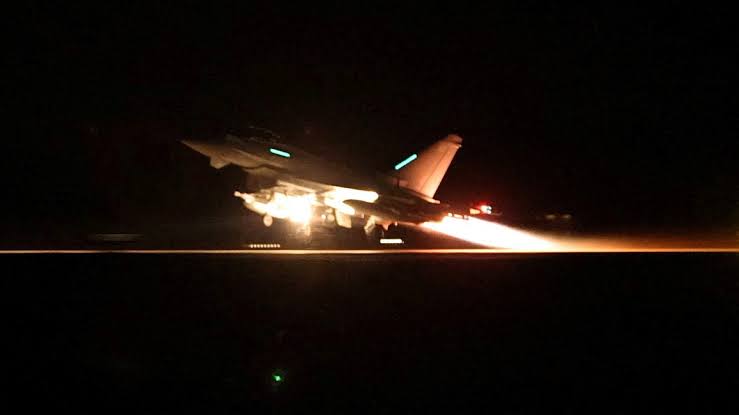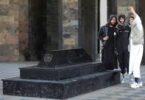WASHINGTON : The US military carried out over a dozen strikes on Houthi targets in Yemen late Thursday, American officials said, marking the first response to attacks carried out by the Iran-backed group in the Red Sea.
Fighter jets, warships and a submarine were conducting the retaliatory attacks on over a dozen targets, one official said, speaking on condition of anonymity. No drone attacks were conducted.
Pentagon chief Lloyd Austin, who remains hospitalized after being diagnosed with prostate cancer, said the strikes targeted sites associated with the Houthis’ unmanned aerial vehicle, ballistic and cruise missile, and coastal radar and air surveillance capabilities. “The United States maintains its right to self-defense and, if necessary, we will take follow-on actions to protect US forces,” Austin said.
A second official familiar with the operation said logistics facilities and radar systems were targeted. Facilities used by the Houthis hit were assessed to not have been housing civilians, according to early assessments.
A senior US military official told reporters that targets were specifically selected to minimize the risk of collateral damage. “We were going after very specific capabilities in very specific locations with precision munitions,” the official said in a phone call.
Asked if the strikes would degrade or deter Houthi capabilities, a senior administration official said on the same call that the US would not hesitate to direct further responses as necessary. “So this may well not be the last word on the topic.”
The attack was conducted with the United Kingdom and with the help of several other countries.
US President Joe Biden said the US and UK, supported by Australia, Bahrain, Canada, and the Netherlands, carried out “successful” strikes. “I will not hesitate to direct further measures to protect our people and the free flow of international commerce as necessary,” he said in a statement.
Al Arabiya English had reported earlier that the US was stepping up contingency plans for a response to Yemen’s Houthis after Washington’s multiple warnings failed to put an end to attacks by the Iran-backed group in the Red Sea.
“Watch this space in the coming days,” one of the sources said. A second source, also not speaking for attribution, said the attack could come within the next 24 hours.
Separately, the US military said that the Houthis launched an anti-ship ballistic missile from areas they control in Yemen on Thursday. The missile was fired into international shipping lanes in the Gulf of Aden, according to the US Central Command (CENTCOM), and marked the 27th Houthi attack on international shipping since Nov. 19.
The top Republican on the Senate Armed Services Committee said the strikes were two months overdue, “but a good first step toward restoring deterrence in the Red Sea.” Senator Roger Wicker said it was important to follow this action in close consultation with Saudi Arabia “to ensure they are with us as the situation develops.”
Washington and 12 other countries issued a warning last week directed at the Houthis. “The Houthis will bear the responsibility of the consequences should they continue to threaten lives, the global economy, and free flow of commerce in the region’s critical waterways,” the joint statement said.
Calls have been increasing for the US to respond. However, some in the US government have voiced concerns over what a potential response could mean for the fragile ceasefire reached in Yemen, which the US has long pushed for.
Reports out of the UK suggested that a government meeting would be held to discuss the situation in the Red Sea and British participation in a joint operation with the US.
The US and UK carried out a joint operation this week where they shot down 18 drones, two anti-ship cruise missiles, and one anti-ship ballistic missile launched by the Houthis.
In the weeks following Houthi attacks on commercial tankers that it said would be targeted for their work with Israel, the US formed a naval task force to protect the ships.
The former CENTCOM chief, retired Gen. Joseph Votel, said the naval task force was a way to try to mitigate the risk but added that “without direct action consequences, it will likely not curb the [Houthis’] actions in a more rapid fashion.”
Votel previously told Al Arabiya English said the naval task force was a way to try to mitigate the risk but added that “without direct action consequences, it will likely not curb the [Houthis’] actions in a more rapid fashion.”
Former US Ambassador to Yemen, Gerald Feierstein, said the Houthis were trying to provoke a US military response, “which they believe would burnish their credentials as a core member of the Iranian ‘axis of resistance’” and be popular with many Yemenis who would see it as a demonstration of support for Palestinians.
But Feierstein, now the director of the Arabian Peninsula Affairs Program at the Middle East Institute, said the best strategy for the US was to continue the current defensive posture in the Red Sea, “which has been largely successful in defeating Houthi attacks, while supporting efforts to end the fighting in Gaza and continuing the Yemen negotiations.”
courtesy : Al arabiya







